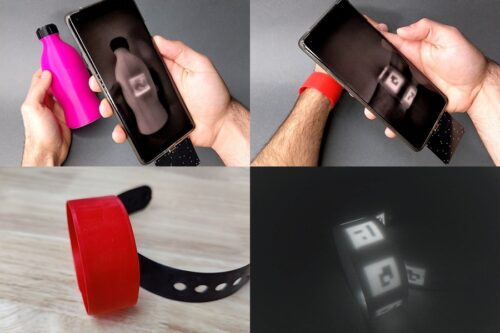Researchers at MIT developed unseen fluorescent tags that enhance object tracking, virtual reality, and the detection of physical items.

As the boundaries between real and digital blur, the need for strong solutions linking physical objects with their digital counterparts grows. QR codes commonly appear on grocery coupons, bulletin board flyers, and museum exhibit walls, each carrying embedded data. These codes in the physical realm might be swapped or altered to deceive you into sharing your data with malicious entities. What appears as innocuous pixels can direct you to harmful links and viruses.
MIT scientists created BrightMarkers: unseen fluorescent markers in objects for better motion tracking, virtual reality, and object detection. They are hidden in 3D-printed objects, such as a ball, container, gadget case, or gear. The researchers believe their system can enhance motion tracking, virtual reality, and object detection. These markers enable ‘ubiquitous metadata’ in the physical world, embedding info like identity and origin. Unlike QR codes, which can be manipulated for data theft, BrightMarkers resist such risks.
To create a BrightMarker, users use software plugins in programs like Blender. After placing the tag in the design, they save it as a Standard Triangle Language (STL) file for 3D printing. Fluorescent filaments in the printer make a hidden tag like an invisible QR code. Markers must be added before fabrication, not to existing items. Fluorescent materials make tags emit specific near-infrared light, visible in high contrast through infrared cameras. Two setups were made to detect BrightMarkers: one for smartphones and another for AR/VR headsets. Both scan markers are akin to glowing QR codes. These are unseen and non-disruptive, preserving object characteristics. This ensures tamper resistance and smooth metadata integration, connecting data and objects for enhanced user interaction.
Applications include across the supply chain, motion tracking, and wearables for limb movements. Another application: night vision monitoring in home security cameras. Unlike its off-the-shelf counterparts, this camera wouldn’t need to capture the user’s whole room, thus preserving their privacy. The limitations include that tags can’t be added post-fabrication. Obstructions like hands hinder tracking. Magnetic filaments enhance detection. More fluorochrome improves marker spotting.
Researchers add that their prior project was limited to black objects, but this offers various colours. Fluorescent filaments emit light filterable by imaging hardware, overcoming blurriness common in markers. This enables effective real-time tracking even during motion. They’re cost-efficient and energy-saving. The team believes this tech can revolutionize real-world tech interactions.









